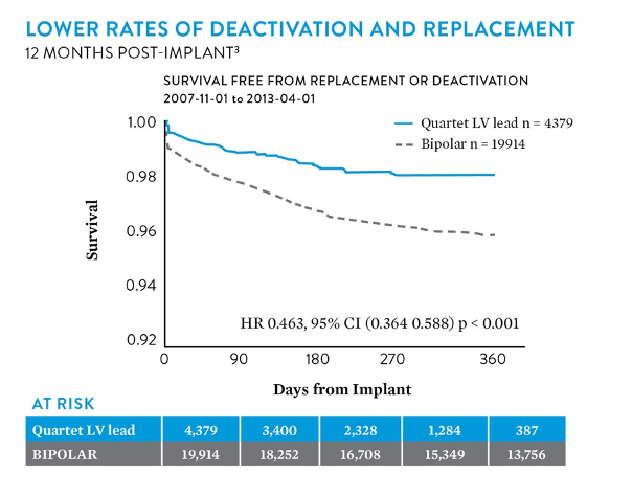Clinical Evidence
Quadripolar Advantages for Cardiac Resynchronization Therapy
Cardiac resynchronization therapy (CRT) is an effective treatment for heart failure, and it can help your patients avoid life-threatening changes in heart rhythm. CRT can also alleviate many of the symptoms experienced by your patients, improving their overall quality of life.
Quadripolar technology offers a significant advantage over bipolar technology—giving you the flexibility you need to access pacing sites and vectors outside of the reach of most devices, without compromising lead stability or performance.
Our Quadripolar CRT System is Associated with Increased Survival
Patients with a quadripolar system may receive more effective CRT than those with bipolar LV pacing:4
Mortality results
Mortality incidence was significantly lower in the quadripolar group.10
- Quadripolar: 5.04 deaths per 100 patient-years
- Bipolar: 6.45 deaths per 100 patient-years (p = 0.001)
After multivariate adjustment, the quadripolar lead was associated with a lower risk of death HR: 0.77; 95% CI: 0.69 to 0.86; p < 0.001.10
Mortality conclusions
CRT with quadripolar LV system was associated with a 22% relative reduction in mortality compared with a bipolar LV system.10
Operational efficiency, implant success and lead performance
In clinical studies, quadripolar pacing technology has resulted in:
- Significantly lower risk of lead deactivation or replacement than bipolar leads3

Benefits of Quadripolar Technology
The use of quadripolar technology offers you and your hospital or clinic many clinical, economic and operational advantages over bipolar technology, including:
Reduced cost
39.8% reduction in
Heart Failure hospitalization cost6
97.4% of patients
Successfully implanted after 18 months Once placed, the LV lead remained stable with excellent pacing thresholds during follow-up (15 ± 5 months)1
54% lower
hospitalization rate5
Overall cost savings
(effective resource utilization)7
Extended battery life by up to 17 months
Among patients with high capture thresholds the use of a quadripolar lead extended battery life significantly4
32.1% reduction
of 30-day readmission rate6
Reduction in phrenic nerve stimulation (PNS)8
and surgical lead revisions9
Improved outcomes
22% relative reduction
in all-cause mortality10
100% of PNS cases
The Quartet LV lead was used to address Phrenic Nerve Stimulation (PNS) cases noninvasively2
Significantly lower capture thresholds
Quartet LV lead has lower capture thresholds when compared to unipolar or bipolar leads3
lower risk of lead deactivation than bipolar leads
Increase in dP/dt with biventricular (BiV) pacing
Increase in dP/dt with biventricular (BiV) pacing
at site of late activation11
Improved hemodynamics12
Reduces Patient and Hospital Costs
Cost analysis performed on a single-center registry showed the Quartet quadripolar LV lead was associated with significantly reduced hospitalizations, specific to heart failure (HF) and left ventricular (LV) lead surgical revision.5
Study Results
- In-patient heart failure hospitalization rates and LV lead surgical revisions were 54% lower for the quadripolar group (0.15/patient-year than for the bipolar LV group (0.32/patient-year) (p = 0.04).5
- The hospitalization rate reduction was accompanied with statistically significant cost savings of 62% (p = 0.016).5
References
- Forleo, G. B., Mantica, M., Di Biase, L., Panattoni, G., Della Rocca, D. G., Papavasileiou, L. P., … Romeo, F. (2012). Clinical and procedural outcome of patients implanted with a quadripolar left ventricular lead: Early results of a prospective multicenter study. Heart Rhythm, 9(11), 1822-1828. https://dx.doi.org/10.1016/j.hrthm.2012.07.021
- Tomassoni, G. Baker, J., Corbisiero, R., Love, C., Martin, D., Niazi, I., … Zhang, Z. (2013). Post-operative performance of the Quartet™ Left Ventriocular Heart Lead. J Cardiovasc Electrophysiol 24(4). 449-456. https://dx.doi.org/10.1111/jce.12065
- Turakhia, M. P., Gold, M. R., Fischer, A., Sloman, L. S., Kumar, C., Dalal, N., … Cao, M., (2013). Decreased rate of left ventricular lead deactivation and replacement associated with use of quadripolar LV leads. Europace, 15(Suppl. 2), S47. https://dx.doi.org/10.1093/europace/eut169
- Manyam, H., Bhimani, A. A., Sadrpour, S. A., De Oliveira, S. A., Goldstein, R., N., Cakulev, I., … Mackall, J. (2013). Quadripolar left ventricular leads yield lower capture thresholds with expected increase in battery longevity. Heart Rhythm, 10(5) S228. https://doi.org/10.1016/j.hrthm.2013.03.019
- Forleo, G. B., Di Biase, L., Bharmi, R., Dalal, N., Panattoni, G., Pollastrelli, A., … Romeo, G. (2015). Hospitalization rates and associated cost analysis of cardiac resynchronization therapy with an implantable defibrillator and quadripolar vs. bipolar left ventricular leads: a comparative effectiveness study. Europace, 17(1), 101-107. https://dx.doi.org/10.1093/europace/euu290
- Corbisiero, R., Kazemian, P., Bharmi, R., Shar, R., Muller, D. (2016). Less with More: Hospitalization cost and Event Rates with Quadripolar versus Bipolar CRT-D. PACE 39(10). 1038-1045. https://dx.doi.org/10.1111/pace.12923
- Graham, C. M., Gayle, J., & Magee, G. (2014, May). Comparison of healthcare utilization and hospital costs for quadripolar versus bipolar LV lead technologies. Presented at the meeting of the Heart Rhythm Society, San Francisco, CA.
- Mehta, P. A., Shetty, A. K., Squirrel, M., Bostock, J., & Rinaldi, C. A. (2012). Elimination of phrenic nerve stimulation occurring during CRT: Follow-up in patients implanted with a novel quadripolar pacing lead. Journal of Interventional Cardiac Electrophysiology, 33(1), 43-49. https://dx.doi.org/10.1007/s10840-011-9598-5
- Viani, S. M., Segreti, L., Di Cori, A., Zucchelli, G., Paperinin, L., Soldati, E., … Bongiorni, M. G. (2011). A new quadripolar lead for left ventricular pacing: Short term reliability and future opportunities. Europace, 13(Suppl. 3).
- Turakhia, M., Cao, M., Fischer, A., Nabutovsky, Y., Sloman, L. S., Dalal, Nirav., Gold, M. R. (2018). Reduced mortality associated with quadripolar compared to bipolar left ventricular leads in cardiac resynchronization therapy. J Am Coll Cardiol EP. 2(4). 426-33. https://dx.doi.org/10.1016/j.jacep.2016.02.007
- Pappone, C., et al. (2012, October). Left ventricular pacing from a site of late electrical activation improves acute hemodynamic response to cardiac resynchronization therapy. Presented at the meeting of the Asia Pacific Heart Rhythm Society, Taipei, Taiwan.
- Gutleben, K. J., Kranig, W., Barr, C., Morgenstern, M. M., Simon, M., & Dalal, Y. H. (2011). LV-pacing: Vector optimization using a novel quadripolar electrode acutely improves cardiac output in cardiac resynchronization therapy patients. Europace, 13(3), P403.
MAT-2212654 v1.0
